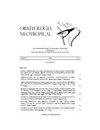SEEDEATERS AND SEEDS AT A TECOMA SAVANNA IN THE SOUTHERN PANTANAL, BRAZIL
IF 0.2
4区 生物学
Q4 ORNITHOLOGY
引用次数: 0
Abstract
Seedeaters (Sporophila spp.) comprise a rich Neotropical bird group of seed consumers common in open habitats. In this study, we documented the feeding habits of seedeaters and seed production at a Tecoma savanna (dominated by Tabebuia aurea) in southern Pantanal, Brazil. We also analyzed the relationship between seed offer (abundance, richness, and diversity) and the number of seedeaters foraging across seasons. Six species (Sporophila angolensis, S. caerulescens, S. collaris S. hypoxantha, S.leucoptera, and S. lineola) occurred in the savanna, mainly in the height of the wet season, when seed production increased abruptly, attracting seedeaters. Seedeaters used 14 of 16 grass species that produced seeds. Indeed, the number of foraging seedeaters paralleled the abundance and diversity of seeds, and the number of species consumed. During much of the dry season, when seeds were not produced, the few remaining seedeaters mostly consumed arthropods and flowers. The diet of seedeaters ranged from mostly seeds (S. angolensis) to a moderate proportion of flowers and arthropods (S. leucoptera). The offer of a rich set of seeds attractive to seedeaters indicates that the Tecoma savanna is a seasonally important habitat for these birds. Of concern, large areas of native grasses in the Pantanal have recently been transformed into exotic pastures, and extensive fires have become common. Thus, conservation of this singular area is important for seedeaters, which move over wide areas searching for an abundant and diverse seed supply.巴西潘塔纳尔南部的tecoma稀树大草原上的食籽动物和种子
食籽鸟(Sporophila spp.)是一种丰富的新热带鸟类,在开阔的栖息地中很常见。在这项研究中,我们记录了巴西潘塔纳尔南部Tecoma稀树草原(以Tabebuia aurea为主)的取食动物的摄食习性和种子产量。我们还分析了种子供给(丰度、丰富度和多样性)与不同季节取食种子的数量之间的关系。热带草原共有6种孢子虫,分别为安哥拉孢子虫(Sporophila angolensis)、caerulescens、S. collaris、S. hypoxantha、S.leucoptera和S. lineola,主要发生在丰水期,此时种子产量急剧增加,吸引了大量取食者。食草动物使用了16种产生种子的草中的14种。事实上,觅食种子的数量与种子的丰度和多样性以及消耗的物种数量是平行的。在旱季的大部分时间里,当种子不产生时,剩下的少数食籽动物主要吃节肢动物和花。取食种子的昆虫以种子为主(S. angolensis),以花和节肢动物为中等比例(S. leucoptera)。丰富的种子吸引着食籽者,这表明Tecoma稀树大草原是这些鸟类的季节性重要栖息地。令人担忧的是,潘塔纳尔的大片原生草地最近已经变成了异国情调的牧场,大面积的火灾已经司空见惯。因此,保护这一独特的区域对种子取食者来说是重要的,它们在广阔的地区寻找丰富多样的种子供应。
本文章由计算机程序翻译,如有差异,请以英文原文为准。
求助全文
约1分钟内获得全文
求助全文
来源期刊

Ornitologia Neotropical
生物-鸟类学
CiteScore
0.50
自引率
0.00%
发文量
0
审稿时长
>12 weeks
期刊介绍:
Ornitología Neotropical welcomes high quality manuscripts concerning ornithological research in the Neotropical region, which includes from Mexico south to Argentina and Chile. Papers on Neotropical species in adjacent areas may be considered at the discretion of the editorial board. While the journal has currently a strong emphasis on natural history, all aspects of avian research are of potential interest. Range extensions and first country records of species are best published in national journals unless the findings have broad implications for the Neotropical region.
 求助内容:
求助内容: 应助结果提醒方式:
应助结果提醒方式:


